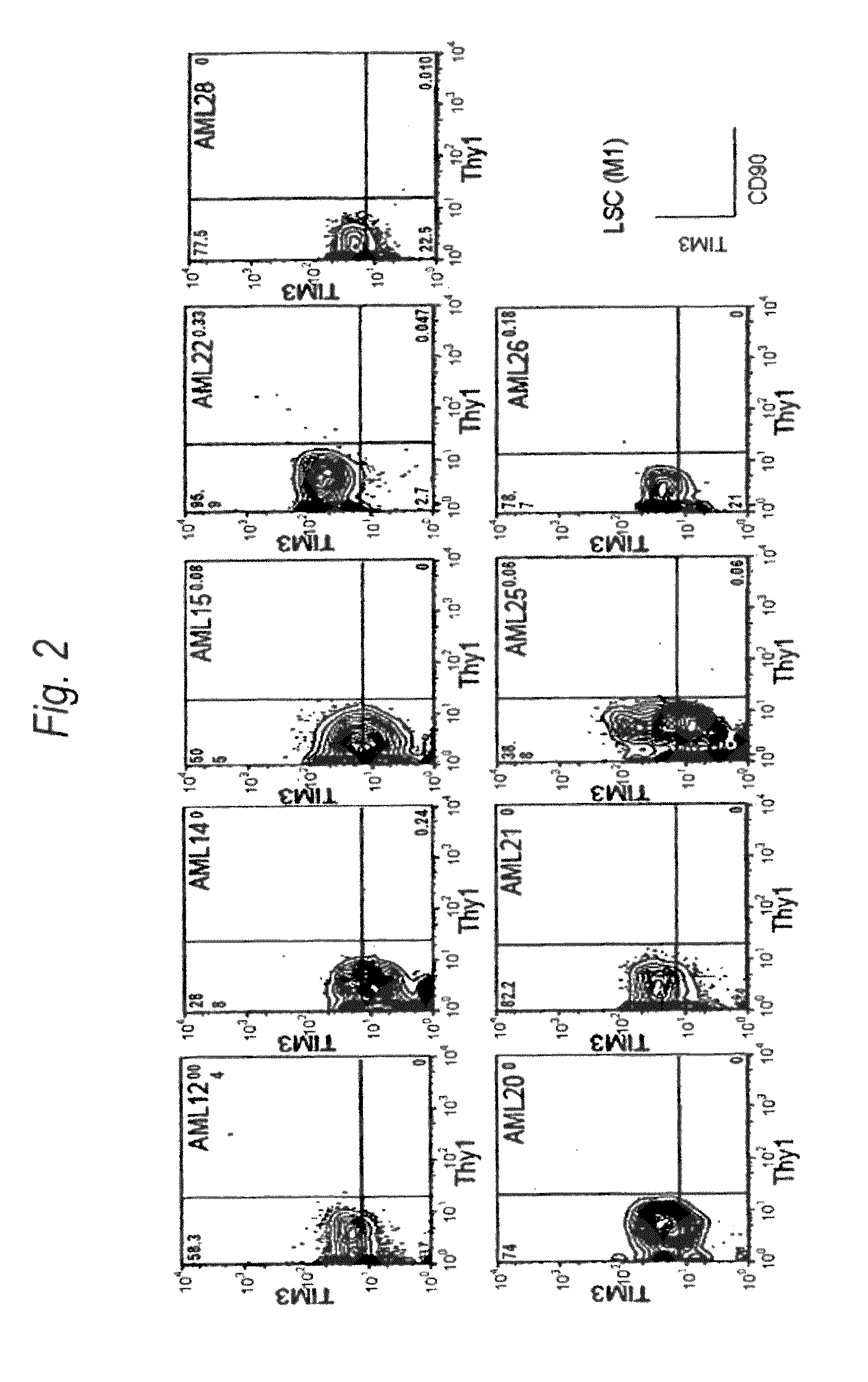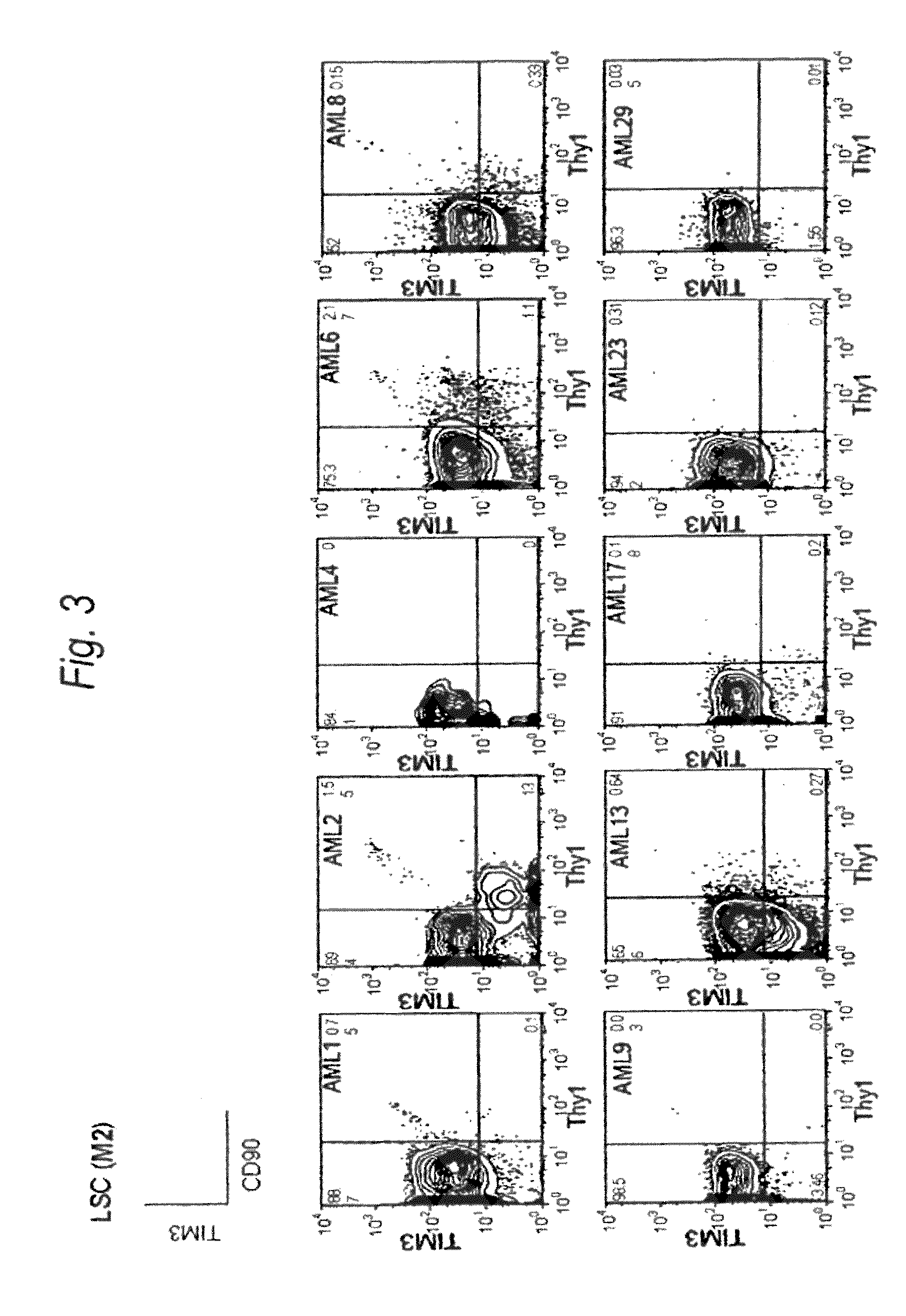Method for treatment of blood tumor using anti-TIM-3 antibody
a technology of blood tumor and anti-tim3 antibody, which is applied in the direction of antibody medical ingredients, instruments, drug compositions, etc., can solve the problems of large side effects, long time-consuming and laborious, and the study of cancer stem cells has been delayed for a long tim
- Summary
- Abstract
- Description
- Claims
- Application Information
AI Technical Summary
Benefits of technology
Problems solved by technology
Method used
Image
Examples
example 1
Preparation of Bone Marrow and Peripheral Blood Cells
[0193]Provision of the analytes from patients and healthy volunteers was carried out under the recognition by an ethical committee at the Kyushu University Hospital. The bone marrow cell was collected by a bone-marrow aspiration from a patient of leukemia or myelodysplastic syndrome and a healthy volunteer. The peripheral blood was collected by an intravenous blood collection from a healthy volunteer. The stem cell-mobilized peripheral blood was collected from a patient indicated for autologous peripheral blood stem cell transplantation (a case in which a patient has a relapse of a diffuse large cell type B cell lymphoma after entering into complete remission with chemotherapy and has sensitivity for the chemotherapy). Specifically, after completion of chemotherapy (Cyclophosphamide (CY) massive dose therapy or VP-16 (etoposide) massive dose therapy), peripheral blood stem cells were mobilized by the administration of a G-CSF prep...
example 2
Staining and Analyzing Methods of Bone Marrow Normal Hematopoietic and Tumor Stem Cells
[0195]The cells were stained using 2 μl of an anti-human CD34 antibody (manufactured by Becton Dickinson & Co., (hereinafter referred to as BD), Cat No. 340441), 20 μl of anti-human CD38 antibody (manufactured by CALTAG, Cat No. MHCD3815), 2 μl of anti-human CD90 antibody (manufactured by BD, Cat No. 555595) or 20 μl of anti-TIM-3 antibody (manufactured by R & D Systems, 344823) as the primary antibodies at 4° C. for 40 minutes. Then, PBS was added for wash, and the obtained suspension was centrifuged at 1500 rpm for 5 minutes. After the supernatant was discarded, 100 μl of the staining medium was added thereto. The obtained cells were stained by adding 5 μl of each of anti-human Lineage antibodies (anti-human CD3 (manufactured by BD, Cat No. 555341), CD4 (manufactured by BD, Cat No. 555348), CD8 (manufactured by BD, Cat No. 555636), CD10 (manufactured by BD, Cat No. 555376), CD19 (manufactured by...
example 3
Expression of Human TIM-3 Molecule in Human Blood Tumor
[0196]Expression of human TIM-3 molecule in human blood tumor was examined using the methods of Example 1 and Example 2.
[0197]Expression of human TIM-3 molecule in AML (M0) patient-derived bone marrow Lin(−)CD34(+)CD38(−) cell, Lin(−)CD34(+)CD38(+) cell and Lin(−)CD34(−) cell was examined by analysis using multicolor flow cytometry. The results are shown in FIG. 1 and Table 1. In the patients with AML (M0), expression of TIM-3 was observed in one of the two cases. Accordingly, this example showed usefulness of TIM-3 as a therapeutic target for AML (M0) cells.
[0198]Expression of human TIM-3 molecule in AML (M1) patient-derived bone marrow Lin(−)CD34(+)CD38(−) cell, Lin(−)CD34(+)CD38(+) cell and Lin(−)CD34(−) cell was examined by analysis using multicolor flow cytometry. The results are shown in FIG. 2 and Table 1. In the patients with AML (M1), expression of TIM-3 was observed in all nine cases. Accordingly, this example showed u...
PUM
| Property | Measurement | Unit |
|---|---|---|
| volume | aaaaa | aaaaa |
| concentration | aaaaa | aaaaa |
| concentration | aaaaa | aaaaa |
Abstract
Description
Claims
Application Information
 Login to View More
Login to View More - R&D
- Intellectual Property
- Life Sciences
- Materials
- Tech Scout
- Unparalleled Data Quality
- Higher Quality Content
- 60% Fewer Hallucinations
Browse by: Latest US Patents, China's latest patents, Technical Efficacy Thesaurus, Application Domain, Technology Topic, Popular Technical Reports.
© 2025 PatSnap. All rights reserved.Legal|Privacy policy|Modern Slavery Act Transparency Statement|Sitemap|About US| Contact US: help@patsnap.com



